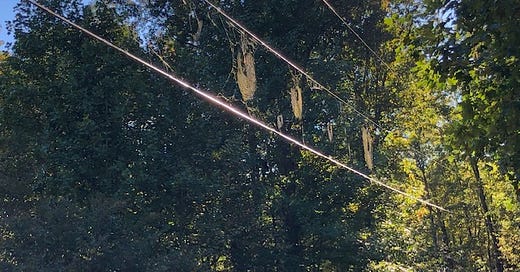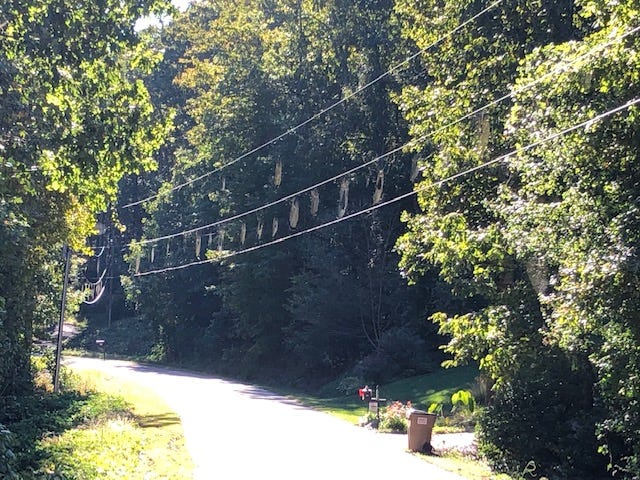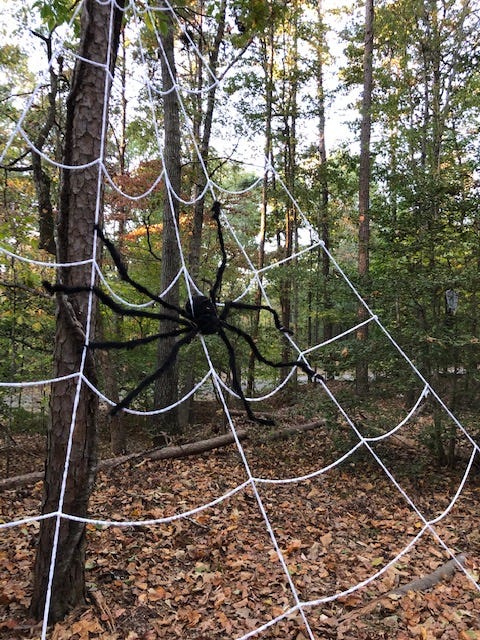Welcome to Natural Wonders, a place where we dig into what’s amazing about hummingbirds and why waterfalls are good for your health and so many other weird and wonderful aspects of the natural world! If you were forwarded this email, feel free to subscribe so as to have it appear magically in your inbox on a regular basis:
There’s something about fall days that makes me nostalgic. It’s a time of endings, of reflection, of reminiscing about the previous seasons before settling in for our long winter’s nap. Animals are fattening up for the winter or, in the case of bees and spiders and many other insects, desperately living out their final days before a cold snap spells the end of their brief time on Earth.
A few weeks ago Andrew noticed an autumn phenomena that has turned into this week’s Natural Wonder: the Joro spiders, those invasive creatures I’ve written about before, have built numerous webs on our power lines. They spread all along our driveway and the neighborhood, sometimes stretching 3-5 feet across.
But here’s the weird part: they seem to only build between the middle and bottom wires. Andrew explained to me that the middle wire is the ground line (which has no power going through it) while the bottom wire is the telephone/cable line. The spiders seem to be avoiding the top wire, which is the only “live” wire that carries electricity.
Is there a reason for this?
Can the spiders sense the presence of electricity? Or does the power line put off a certain hum – is it the sound that deters them? Why are they avoiding the upper space on the power line?
Do spider webs conduct electricity?
One of the first fascinating things I discovered is that spiders can hear through their webs. Despite being full of holes, the web acts almost like a delicate satellite dish, capturing sound vibrations and sending them back to the spider along the strands of the web. When scientists targeted a web with sound from different angles, the spiders were able to pinpoint the source with 100% accuracy. Spiders are able to hear sound as quiet as 68 decibels, which is the level of a normal conversation between two people.
As if spiders aren’t creepy enough, now it turns out they’re listening to you…
By the way, they “hear” the sound vibrations along their web through their tarsal claws, tiny talons at the end of their legs that they use to balance on the web:
So perhaps the hum of power lines overwhelms the extra-sensitive spiders’ hearing and that’s why they avoid live wires?
But here’s where it gets really weird…
The glue that covers the strands of a spider’s web causes it to be electrostatically charged so when something floats or flies by – pollen, pollutants, an insect – the web actually reaches out to grab the object.
Spider webs are electrically charged! (Albeit, with tiny, static electricity levels of energy).
Scientists haven’t studied all insects, but they do know that honeybees generate a positive charge as they fly – they can generate up to 200 volts as they dart from flower to flower. Flowers are negatively charged, and this difference in electrical charge is partly why pollen sticks to bees when they land.
So, when a honeybee flies too close to a negatively-charged spider web, the tiny strands actually reach out to grab the insect. You can see it in this 6-second, slow-motion video here:
You have to look really closely (I had to replay the video a couple times to see it), but the strands really do reach up to capture the bee before it can fall through the holes in the web.
Not only does the electrical charge of a spider web capture insects, it also attracts pollen and airborne pollutants. Scientists have found this very useful:
‘The elegant physics of these webs make them perfect active filters of airborne pollutants including aerosols and pesticides,' said Professor Fritz Vollrath of Oxford University's Department of Zoology, who led the study. 'Electrical attraction drags these particles to the webs, so you could harvest and test webs to monitor pollution levels -- for example, to check for pesticides that might be harming bee populations.’
But there’s a potential problem with webs filtering pollutants – spiders generally recycle their webs each night…by eating them. I actually observed this earlier in the summer when I saw what must have been a frantic spider running WAY behind on remaking his web (it was mid-morning) or either a perfectionist spider dissatisfied with his earlier attempt. Either way, he was rapidly dismantling the web he’d built by our swing (which overlooks our waterfall, so that’s why it’s a bit loud):
In the moment it wasn’t apparent what was happening with the old web, but some online research tells me he was eating the filaments as he scurried up and down.
Back to the problem this causes: because the web is charged and attracts potential pollutants, spiders that ingest their webs each night could end up consuming detrimental pesticides. Too many pollutants, and it may affect spiders’ abilities to build a web:
“Even more fascinating, you would be able to detect some airborne chemicals just by looking at the shape of the webs! [says Professor Fritz] We already know that spiders spin different webs when on different drugs, for example creating beautiful webs on LSD and terrible webs on caffeine. As a result, the web shapes alone can tell us if any airborne chemicals affect the animal's behavior.”
Wait – what?! Spiders on LSD and caffeine?


It’s true – researchers have given spiders illicit drugs (using sugar water and Q-tips – not injections or tiny cigarettes) just to see if it affects them in ways similar to humans. And it does.
While the photos above are all legit, Snopes reports that social media posts have combined photos from several different studies, and so the pictures above are not all from the NASA study. Regardless, spiders on caffeine built erratic webs and those on depressants “forgot” to finish their webs. Spiders on LSD concentrated remarkably well, seemingly unaware of outside influences, and created very carefully constructed webs:
If you’d like to hear the rest of the story, watch this video (language warning, NSFW).
OK, we’ve gotten a little sidetracked into the world of spiders on psychoactive drugs, but that’s what happens when you’re exploring the World Wide Web, so aptly named because it reaches out and grabs you, tangling you in its sticky embrace for hours at a time… what was the original question?
Oh, yes – spider webs and electricity. While I was not able to find anything that specifically addressed why spiders might avoid building on powerlines, it appears that spider webs are electrically charged and that they act as giant ears for collecting sound, both of which might cause a spider to avoid charged lines.
Therefore, while we don’t have a verifiable source for a definitive answer, I think we’ll have to call it plausible that spider webs conduct electricity.










With regard to the spider webs, an interesting hypothesis, but it seems you may be confounding wire spacing with presence of current. From your images, it is clear that the space between the top wire and the middle is larger than the middle to bottom. You can do the experiment to decide between these hypotheses---- for the current idea, all you need to do is turn the power off for a couple of months (smile). For testing the spacing, all you have to do is move that top wire down to make the spacing the same (smile, again). Or you could look for lines with equal spacing, but that would be less fun.
The equivalent spider in Florida is the golden silk spider, a really beautiful, impressive spider. You refer to the webs of the Joro as "he", but in fact, males of both the Joro and the golden silk spider are very small and occupy auxiliary webs near the female web. From there, males try to sneak in to mate the female without getting eaten. Risky business...
Wow, this is very fascinating! Thank you for sharing and this is a subscribe for me!